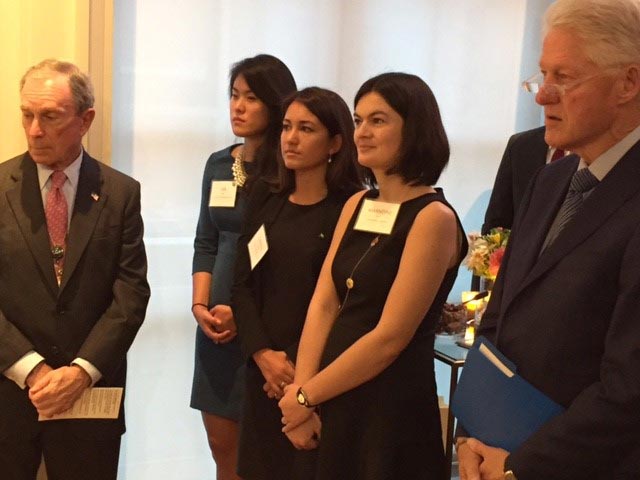Hanya Gartner: Driving sustainable change
Living through Australia’s Millennium drought saw Hanya Gartner redirect her desire to make an impact into the sustainability space. The Master of Environment alum is now Sustainability Manager at The Port Authority of New York & New Jersey. Recently, she spoke with us over Zoom about her journey into sustainability, common misconceptions, and why an interdisciplinary approach, centered around environmental justice considerations is critical to solving environmental problems.
A desire for social impact
 “What motivates me is finding meaning in my day to day job,” Hanya shares. “Knowing that the blood, sweat and tears that I put into my work actually has a positive impact on society, whether that’s within the smallest council, the national level, or even the global level. I don’t want recognition for it, I just want to know that my life meant something and contributed positively to people.”
“What motivates me is finding meaning in my day to day job,” Hanya shares. “Knowing that the blood, sweat and tears that I put into my work actually has a positive impact on society, whether that’s within the smallest council, the national level, or even the global level. I don’t want recognition for it, I just want to know that my life meant something and contributed positively to people.”
Hanya’s early years as a civil engineer coincided with Australia’s prolonged Millennium drought, which got her thinking about the impact she could make in the sustainability space.
“I’ve always loved tinkering and problem solving, which is the reason why I initially went into civil engineering; but after working in a technical field for eight years, you can be very siloed to one way of thinking,” Hanya explains. “I realised that there are bigger and more complex problems to grapple with, and I want to be solving those problems.
“The Master of Environment was fundamental to moving into a more policy oriented, sustainability type of role that I’m in now.”
Hanya is now the Sustainability Manager at the Port Authority of New York and New Jersey.
“The Port Authority of New York and New Jersey is a quasi-government agency. We own and operate all the major airports, the bridges and tunnels connecting New York and New Jersey to one another, the major ports in New York and New Jersey, and a train system, as well as real estate,” Hanya says of her current role.
“I like being in an organisation, persuading people outside of the space about why environment and sustainability is important, and that it is critical to the bottom line of a company. It’s a huge challenge, but once you have those wins, it happens really quickly. We’re actually seeing direct financial benefit from driving sustainability and climate action.”
A global and multi-disciplinary approach
Hanya says that the Master of Environment gave her the global perspective she needed to transition into the international sustainability space. The diversity that Hanya’s peers brought to the classroom during the master’s also added value beyond the curriculum.
“There were so many people from across different countries, which prepared me for my transition out of Australia and into these roles that I’ve had in New York City,” Hanya shares.
“I think the most important thing in the whole course was that everyone was coming from different disciplines. You had former lawyers, former journalists, former economists, former engineers, former scientists, all convening to solve the same problem but with the different lenses that they had”.
“Environmental problems can’t be solved with just one discipline. It’s an interdisciplinary issue that we’re dealing with.”
Environmental justice
Hanya wants to see more cultural diversity and representation in the environmental and sustainability space so that these intersecting injustices can be addressed.
In order to move this dialogue, when it comes to sustainability, when it comes to climate change, we need to have diverse people at the table to talk about it. We can’t all be thinking from one discipline, and we cannot be thinking about it from one narrow cultural perspective, because we all view the environment and climate change completely differently.
With conversations around environmental justice gaining traction in the United States, Hanya emphasises how important having a diversity of perspectives is when it comes to sustainability.
“In order to address racial inequities, you have to also address environmental injustices,” Hanya explains. “With the coronavirus [in the USA], we now know that a lot of minority communities were living in areas where they were constantly exposed to poor air quality, making these communities susceptible to asthma and other respiratory illnesses and therefore more susceptible to implications associated with coronavirus, because they already had these underlying health issues based on the environmental factors that were occurring in the locations.
“Just like the coronavirus is disproportionately impacting people of colour, environmental justice acts in the same way, in that the majority of toxic waste dumps, transportation corridors, airports, the air polluting heavy industries are located in areas of minority groups or people that don’t have the same financial means that the more well-to-do people have, who can often more successfully argue against having heavy emitting facilities in their areas, or move to areas with better conditions.”
Driving change
 Transitioning into the sustainability sector highlighted for Hanya the misconceptions she had about who was capable of driving sustainable change.
Transitioning into the sustainability sector highlighted for Hanya the misconceptions she had about who was capable of driving sustainable change.
“I always assumed that it was up to national governments to address climate change or sustainability more broadly,” Hanya shares. “But cities also have a really significant role to play. Some of the biggest cities in the world have millions of people living in them, and mayors often have a lot of autonomy to create their own policies, be nimble and drive change within their cities.”
Cities are where the future happens first, essentially. The ecosystem required to drive innovation is often concentrated in cities. Ideas and technology can be incubated in cities with local access to capital, policy makers and talent Problems can be solved in these cities and then rolled out to the rest of the country and the world.
The corporate sector also represents an area of growing interest in driving sustainable innovation.
“You’re starting to see that shareholders care, consumers care, employees care about sustainability,” Hanya explains. “Corporations are actually taking a leading role and, in some cases, doing better than governments. Government policy changes often face a lot of roadblocks, and the process can be very slow and cumbersome.”
Hanya sees this as an exciting space for people looking to move into sustainability, but who might be worried about the breadth of opportunities. She herself was once worried that she would be confined to working in the non-profit and government world. But it hasn’t been the case at all.
“I haven’t found it difficult to get a role in sustainability at all,” Hanya reflects. “As corporations and the financial sectors are starting to embrace sustainability, and take it a lot more seriously, there are actually more high-paying roles, because it is a specialised area.
“In my opinion, there’s short supply of sustainability professionals with the right skills. It is helpful to have technical knowledge, the ability to number crunch and work collaboratively across disciplines.
“If you have a skillset in something that you’ve taken from your undergraduate degree or a past career, and then you layer on sustainability, there will be a niche for that, and there will be a company or an organization that’s looking for that particular skillset.”
Connect with Hanya Gartner and join the Science Alumni Group on LinkedIn.